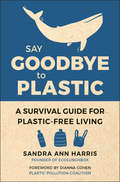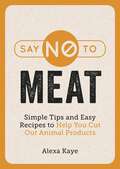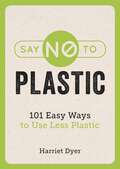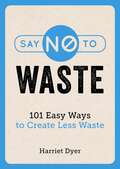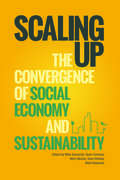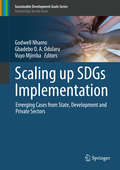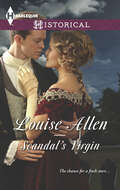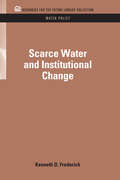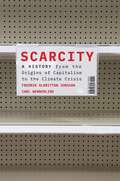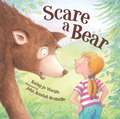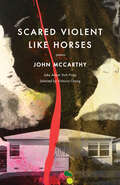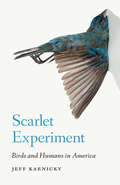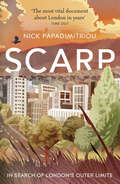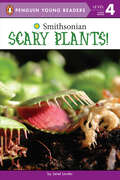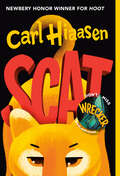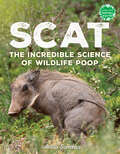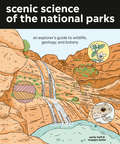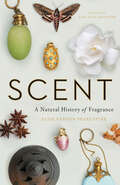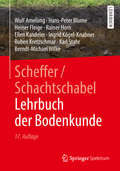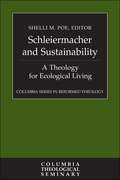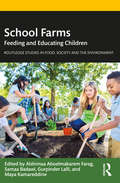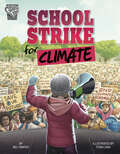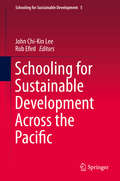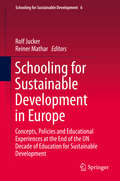- Table View
- List View
Say Goodbye to Plastic: A Survival Guide for Plastic-Free Living
by Sandra Ann HarrisA simple and powerful book educating people about the epidemic of plastic use and solutions for a plastic-free future.If you've heard of the plastic-free lifestyle, but think you don't have time for it in your busy life, prepare to be delightfully wrong. Goodbye Plastic shows you how, whether you're seeking to knock plastic out of your life or just try out a few novel eco-hacks in your kitchen, bathroom, office or dining room. Plastic pollution activist and entrepreneur Sandra Ann Harris invites us to say goodbye to plastic, room by room. Opportunities abound to simplify our lives by re-thinking our wasteful habits--we just need to learn to recognize them.
Say No to Meat: Simple Tips and Easy Recipes to Help You Cut Out Animal Products
by Alexa KayeCutting out animal products has never been easier!From eco to ethical, there are plenty of sound reasons to eat less meat. It’s possible to make positive changes to your diet without radically altering your lifestyle – and you can still eat tasty, nutritious food without feeling like you’re missing out. This practical book is full of nutritional tips, lifestyle hacks and delicious meat-free recipes, so that you’ll find it easy to take the first step and make a difference.
Say No to Plastic: 101 Easy Ways to Use Less Plastic
by Harriet DyerWe’ve reached an environmental crisis point with plastic, and it’s time to take action. But is it possible to make positive changes without radically changing your lifestyle? Absolutely! This practical book suggests eco-friendly alternatives to plastic, including budget options, high-street substitutes and DIY ideas to help you drastically reduce your plastic consumption. With 101 simple ways to use less plastic, you’ll find it easy to take the first step and make a difference.
Say No to Waste: 101 Easy Ways to Create Less Waste
by Harriet DyerThe world is overflowing with waste. It’s time to take action. You can make positive changes without radically altering your lifestyle. This practical book suggests ways to reduce waste, including how to cut unnecessary packaging, patch up or recycle old household items and drastically limit food waste. With 101 simple ways to create less waste, you’ll find it easy to take the first step and make a difference.
Scaling Up: The Convergence of Social Economy and Sustainability
by Mike Gismondi Mark Roseland Sean Markey Mary Beckie Sean ConnellyWhen citizens take collaborative action to meet the needs of their community, they are participating in the social economy. Co-operatives, community-based social services, local non-profit organizations, and charitable foundations are all examples of social economies that emphasize mutual benefit rather than the accumulation of profit. While such groups often participate in market-based activities to achieve their goals, they also pose an alternative to the capitalist market economy. Contributors to Scaling Up investigated innovative social economies in British Columbia and Alberta and discovered that achieving a social good through collective, grassroots enterprise resulted in a sustainable way of satisfying human needs that was also, by extension, environmentally responsible. As these case studies illustrate, organizations that are capable of harnessing the power of a social economy generally demonstrate a commitment to three outcomes: greater social justice, financial self-sufficiency, and environmental sustainability. Within the matrix of these three allied principles lie new strategic directions for the politics of sustainability. Whether they were examining attainable and affordable housing initiatives, co-operative approaches to the provision of social services, local credit unions, farmers’ markets, or community-owned power companies, the contributors found social economies providing solutions based on reciprocity and an understanding of how parts function within the whole—an understanding that is essential to sustainability. In these locally defined and controlled, democratically operated organizations we see possibilities for a more human economy that is capable of transforming the very social and technical systems that make our current way of life unsustainable.Contributors to the volume are Mary Beckie, Randy Bell, Marena Brinkhurst, Kailey Cannon, Sean Connelly, Mike Gismondi, Lillian Hunt, Noel Keough, Freya Kristensen, Celia Lee, Mike Lewis, Julie L. MacArthur, Terri MacDonald, Sean Markey, Juanita Marois, George Penhold, Stewart Perry, John Restakis, Lauren Rethoret, Mark Roseland, Lynda Ross, Erin Swift-Leppakumpu, and Kelly Vodden.
Scaling up SDGs Implementation: Emerging Cases from State, Development and Private Sectors (Sustainable Development Goals Series)
by Godwell Nhamo Vuyo Mjimba Gbadebo O. A. OdularuThis volume challenges global leaders and citizenry to do more in order to resource the implementation of the 2030 Agenda for Sustainable Development (AfSD) and its 17 interwoven Sustainable Development Goals (SDGs). Starting from the concept ‘we cannot manage what we cannot measure’, the book presents some cases showing how to draw national level baselines for the domestication and localisation of the SDGs seeking to provide a clear roadmap towards achieving the 2030 AfSD. Scaling up SDGs Implementation is targeted at the United Nations, national and state governments, sub-national governments, the corporate sector and civil society, including higher education institutes, labour groups, non-governmental organisations and youth movements. The book is cognizant of these institutions’ common, but differentiated responsibilities and capabilities within their socio-political, environmental and economic conditions. The book presents case studies of how the corporate sector has been scaling up SDGs implementation, from the tourism sector, insurance, to the aviation and agricultural sectors. To make sure that no one is left behind, the volume includes cases on solutions for pressing environmental and socio-economic problems ranging from cooperatives in Brazil to the conservation of springs in Zimbabwe. The matter of finding synergies between the climate SDG and the Paris Agreement’s Nationally Determined Contributions (NDCs) is elaborated at length. Lastly, the book discusses how institutions of higher education remain critical pillars in SDGs scaling up, with cases of curriculum re-orientation in South Africa to the rolling out of the Women’s University in Africa. In this context, this volume challenges every global citizen and organization to invest every effort into making the implementation of the SDGs a success as we welcome the second four to five year segment down the road to the year 2030.
Scandal's Virgin: Bride By Mail Scandal's Virgin No Place For An Angel
by Louise AllenA lady with a secret sorrow Reeling from heartbreak, Lady Laura Campion transformed herself into the infamous Scandal's Virgin of high society-flirtatious, alluring and utterly shocking-yet always stopping short of absolute ruin. But now she has new hope-the daughter she thought lost is alive, and under the guardianship of the powerful Avery Falconer, Earl of Wykeham. Going into battle against Lord Wykeham may be her only option to win little Alice back, but she doesn't expect the irresistible attraction that simmers between her and the formidable Earl. Laura finally has a chance at happiness, but can she persuade Avery to forgive her past? "Allen reaches into readers' hearts." -RT Book Reviews on Married to a Stranger
Scarce Water and Institutional Change (RFF Water Policy Set)
by Kenneth D. FrederickThe authors assess alternative approaches to meeting long-term water needs and resolving conflicts among competing water users in five areas: the Columbia River Basin; Kern County, California; south California; Virginia Beach, Virginia; and northeastern Colorado. This book argues that America's water supply problems are caused largely by bad habits and poor policies-especially policies that price water far under its true value. Originally published in 1986
Scarcity: A History from the Origins of Capitalism to the Climate Crisis
by Carl Wennerlind Fredrik Albritton JonssonA sweeping intellectual history of the concept of economic scarcity—its development across five hundred years of European thought and its decisive role in fostering the climate crisis.Modern economics presumes a particular view of scarcity, in which human beings are innately possessed of infinite desires and society must therefore facilitate endless growth and consumption irrespective of nature’s limits. Yet as Fredrik Albritton Jonsson and Carl Wennerlind show, this vision of scarcity is historically novel and was not inevitable even in the age of capitalism. Rather, it reflects the costly triumph of infinite-growth ideologies across centuries of European economic thought—at the expense of traditions that sought to live within nature’s constraints.The dominant conception of scarcity today holds that, rather than master our desires, humans must master nature to meet those desires. Albritton Jonsson and Wennerlind argue that this idea was developed by thinkers such as Francis Bacon, Samuel Hartlib, Alfred Marshall, and Paul Samuelson, who laid the groundwork for today’s hegemonic politics of growth. Yet proponents of infinite growth have long faced resistance from agrarian radicals, romantic poets, revolutionary socialists, ecofeminists, and others. These critics—including the likes of Gerrard Winstanley, Dorothy Wordsworth, Karl Marx, and Hannah Arendt—embraced conceptions of scarcity in which our desires, rather than nature, must be mastered to achieve the social good. In so doing, they dramatically reenvisioned how humans might interact with both nature and the economy.Following these conflicts into the twenty-first century, Albritton Jonsson and Wennerlind insist that we need new, sustainable models of economic thinking to address the climate crisis. Scarcity is not only a critique of infinite growth, but also a timely invitation to imagine alternative ways of flourishing on Earth.
Scare a Bear
by Kathy-Jo WarginScare a Bear. Do you know how to scare a bear? Would you bang pots and pans? Would you rattle some cans? Would you shout? Would you yell? Would you ring a loud bell? Do you know how to scare a bear? How would you scare a bear out of your cabin? Or out of your fishing boat? How about away from your campfire? And what if he climbed in your bunk? Would the bed go kerplunk? From the author-illustrator team who created Moose on the Loose comes yet another example of the high jinks and hilarity that happens when wildlife wanders indoors. In this contest of wills, who will win? And once again, by story's end, young campers will know exactly how to scare a bear!
Scarecrow
by Cynthia Rylant Lauren StringerScarecrows. They perch high above gardens and fields, with borrowed coats and button eyes and pie-pan hands that glint in the sun. What else is there to know about them? Perhaps more than we realize. Newbery Medalist Cynthia Rylant's rich and poignant story, powerfully illustrated by Lauren Stringer, will resonate deeply in the hearts of readers, who just might find themselves seeing the world in a whole new way.
Scared Violent Like Horses: Poems
by John McCarthyIn this poetry collection, the author of Ghost Country deeply examines violent masculinity, driven by a yearning for more compassionate ways of being.McCarthy’s flyover country is populated by a family strangled by silence: a father drunk and mute in the passenger seat, a mother sinking into bed like a dish at the bottom of a sink, and a boy whose friends play punch-for-punch for fun. He shows us a boy struggling to understand pain carried down through generations and how quickly abandonment becomes a silent kind of violence; “how we deny each other, daily, so many chances to care,” and how “we didn’t know how to talk about loss, / so we made each other lose.” Constant throughout is the brutality of the Midwestern landscape that, like the people who inhabit it, turns out to be beautiful in its vulnerability: sedge grass littered with plastic bags floating like ghosts, dilapidated houses with abandoned Fisher Price toys in the yard, and silos of dirt and rust under a sky that struggles to remember the ground below.With arresting lyricism and humility, Scared Violent Like Horses attends to the insecurities that hide at the heart of what’s been turned harsh, offering a smoldering but redemptive and tender view of the lost, looked over, and forgotten.Selected by Victoria Chang as winner of the Jake Adam York PrizePraise for Scared Violent Like Horses“McCarthy’s book of Midwestern threnodies begins in image and ends in solemnity . . . McCarthy’s poems are profluent stories?a joy to marvel at this skill, impressive considering the book’s bleak landscape.” —The Millions“McCarthy has whittled out a sense of freedom from the heartache of the past, and the reader is left with a remarkable vision.” —Booklist“In unshowy, plaintive, quietly delivered language that should not be mistaken for affectless?and that can be stabbed through with surprisingly piercing metaphor—McCarthy vivifies a place and hard way of life too little visited.” —Library Journal“Ultimately, what the reader is left with is a stunning overlap of lost boy and lost landscape glimpsed through the lens of a gifted poet’s magical linguistic and storytelling abilities.” —Victoria Chang“A book that grabs the reader with its insistent lyric beauty.” —Allison Joseph
Scarlet Experiment: Birds and Humans in America
by Jeff KarnickyEmily Dickinson’s poem “Split the Lark” refers to the “scarlet experiment” by which scientists destroy a bird in order to learn more about it. Indeed, humans have killed hundreds of millions of birds—for science, fashion, curiosity, and myriad other reasons. In the United States alone, seven species of birds are now extinct and another ninety-three are endangered. Conversely, the U.S. conservation movement has made bird-watching more popular than ever, saving countless bird populations; and while the history of actual physical human interaction with birds is complicated, our long aesthetic and scientific interest in them is undeniable. Since the beginning of the modern conservation movement in the mid-nineteenth century, human understanding of and interaction with birds has changed profoundly. In Scarlet Experiment, Jeff Karnicky traces the ways in which birds have historically been seen as beautiful creatures worthy of protection and study and yet subject to experiments—scientific, literary, and governmental—that have irrevocably altered their relationship with humans. This examination of the management of bird life in America from the nineteenth century to today, which focuses on six bird species, finds that renderings of birds by such authors as Henry David Thoreau, Emily Dickinson, Don DeLillo, and Christopher Cokinos, have also influenced public perceptions and actions. Scarlet Experiment speculates about the effects our decisions will have on the future of North American bird ecology.
Scarp
by Nick PapadimitriouNick Papadimitriou has spent a lifetime living on the margins, walking and documenting the landscapes surrounding his home in Child's Hill, North London, in a study he calls Deep Topography. Part meditation on nature and walking, part memoir and part social history, his arresting debut is first and foremost a personal inquiry into the spirit of a place: a 14-mile broken ridge of land on the fringes of Northern London known as Scarp. Conspicuous but largely forgotten, a vast yet largely invisible presence hovering just beyond the metropolis, Scarp is a vast storehouse of regional memory. We join the author as he explores and reimagines this brooding, pregnant landscape, meticulously observing his surroundings, finding surprising connections and revealing lost slices of the past. SCARP captures the satisfying experience of a long, reflective walk. Whether talking about the beauty of a bird or a telegraph pole, deaths at a roundabout or his own troubled past, Papadimitriou celebrates the poetry in the everyday. His captivating prose reveals that the world around us is alive and intrinsically valuable in ways that the trappings of day-to-day life lead us to forget, and allows us to re-connect with something more authentic, more immediate, more profound.
Scary Plants! (Smithsonian)
by Janet LawlerDanger! Watch out for these plants! Poison ivy, stinging nettles, Venus fly trap—their names alone say "watch out!" Plants can sting, prick, trap, even poison other living things. But why? Learn more about the tricky or deadly ways some plants protect themselves and capture food in this visually exciting book developed with Smithsonian Gardens.
Scat
by Carl HiaasenCarl Hiaasen takes us deep in the Everglades with an eccentric eco-avenger, a ticked-off panther, and two kids on a mission to find their missing teacher. Florida—where the animals are wild and the people are wilder! Bunny Starch, the most feared biology teacher ever, is missing. She disappeared after a school field trip to Black Vine Swamp. And, to be honest, the kids in her class are relieved. But when the principal tries to tell the students that Mrs. Starch has been called away on a "family emergency," Nick and Marta just don't buy it. No, they figure the class delinquent, Smoke, has something to do with her disappearance. And he does! But not in the way they think. There's a lot more going on in Black Vine Swamp than any one player in this twisted tale can see. It&’s all about to hit the fan, and when it does, the bad guys better scat. &“Ingenious . . . Scat won&’t disappoint Hiaasenphiles of any age.&” —The New York Times &“Woohoo! It&’s time for another trip to Florida—screwy, gorgeous Florida, with its swamps and scammers and strange creatures (two- and four-legged). Our guide, of course, is Carl Hiaasen.&” —DenverPost.com
Scat: The Incredible Science of Wildlife Poop (Books for a Better Earth)
by Anita SanchezDiscover how poop can actually help protect our planet in this nonfiction book on the nutrient cycle and scientific problem solving.What could be more revolting, useless, and downright disgusting than poop? But in nature&’s endless and complex cycles, there&’s no such thing as waste. The poop of wild animals is full of surprising power: it can be food, shelter, a way for creatures to communicate, and more. For scientists, scat can reveal clues about how animals are responding to climate change threats.From researchers in India using tiger poop to track the endangered big cat to scientists in Mexico using bat guano to help replant a forest destroyed by fire, Scat shows how scientists are getting creative when it comes to studying animals and protecting ecosystems from climate change.Award-winning nonfiction author Anita Sanchez&’s writing is clear, concise, and lightly punny, providing readers with an accessible introduction to the nutrient cycle and the world of animal poop that is aligned with Next Generation Science Standards. Back matter includes a glossary, a photo guide to common animal scat, and more. A Books for a Better Earth™ TitleA Junior Library Guild Gold Standard Selection
Scenic Science of the National Parks: An Explorer's Guide to Wildlife, Geology, and Botany
by Emily Hoff Maygen KellerExplore the fascinating science behind the national parks in this charming illustrated guide. The national parks are some of the most beloved, visited, and biodiverse places on Earth. They're also scientific playgrounds where you can learn about plants, animals, and our planet's coolest geological features firsthand. Scenic Science of the National Parks curates and breaks down the compelling and offbeat natural science highlights of each park, from volcanic activity, glaciers, and coral reefs to ancient redwood groves, herds of bison, giant bats, and beyond. Featuring full-color illustrations, information on the history and notable features of each park, and insider tips on how to get the most out of your visit, this delightful book is the perfect addition to any park lover's collection.
Scent: A Natural History of Fragrance
by Elise Vernon PearlstineA fascinating exploration of the natural history of scent and human perceptions of fragrance from the viewpoint of plant and pollinator &“An evocative journey that awakens one&’s curiosity to an oft-forgotten sense.&”—Dana Dunham, Scientific American Plants have long harnessed the chemical characteristics of aromatic compounds to shape the world around them. Frankincense resin from the genus Boswellia seals injured tissues and protects trees from invading pathogens. Jasmine produces a molecule called linalool that attracts pollinating moths with its flowery scent. Tobacco uses a similarly sweet-smelling compound called benzyl acetone to attract pollinators. Only recently in the evolutionary history of plants, however, have humans learned to co-opt their fragrances to seduce, heal, protect, and alter moods themselves. In this wide-ranging and accessible new book, biologist-turned-perfumer Elise Vernon Pearlstine turns our human-centered perception of fragrance on its head and investigates plants' evolutionary reasons for creating aromatic molecules. Delving into themes of spirituality, wealth, power, addiction, royalty, fantasy, and more, Pearlstine uncovers the natural history of aromatic substances and their intersection with human culture and civilization.
Scheffer/Schachtschabel Lehrbuch der Bodenkunde: Lehrbuch Der Bodenkunde
by Karl Stahr Hans-Peter Blume Heiner Fleige Rainer Horn Ellen Kandeler Ingrid Kögel-Knabner Ruben Kretzschmar Wulf Amelung Berndt-Michael WilkeDie 17. Auflage dieses renommierten Lehrbuches vermittelt ein umfassendes Wissen über Böden und deren Schutz. Böden bilden eine der wichtigsten Grundlagen für das terrestrische Leben. Für einen effektiven Schutz und Erhalt dieses Lebensraums braucht es ein grundlegendes Verständnis der Prozesse, die Böden formen, sowie der Eigenschaften der Böden selbst. Dieses Buch fasst den neusten Kenntnisstand der Forschung zusammen und vermittelt ein umfassendes Wissen der Bodenkunde. Im Detail werden behandelt: die Vorgänge der Bodenbildung und -entwicklung,die physikalischen, chemischen und biologischen Eigenschaften und Prozesse, Nähr- und Schadstoffe,die verschiedenen Bodensystematiken, die wichtigsten Böden und Bodenlandschaften,die Nutzungsbewertung der Böden, Grundsätze des Bodenschutzes. Die 17. Auflage wurde überarbeitet und ergänzt. Neu ist ein Kapitel zu Nanopartikeln als Schadstoffe im Boden. Durch seine Ausführlichkeit ist dieses Buch ein Must-Have für alle, die sich mit Böden befassen.
Schleiermacher and Sustainability: A Theology For Ecological Living
by Shelli PoeSince the 1960s, theologians have been involved in efforts to guide Christians to reflection and action in light of planetary peril. The contributors to this volume illustrate how Friedrich Schleiermacher's theological work could fulfill that need. Schleiermacher's theology, they contend, finds its culmination in Christian social action and is remarkably conducive to ecological thinking in the modern world. <P><P> Each chapter deals with a particular locus in Schleiermacher's systematic theology, focusing on its implications for sustainable living. In so doing, Schleiermacher and Sustainability offers a sophisticated account of Schleiermacher's thought that will upend many estimations of his value for current constructive theology and provide a potent resource for those seeking to integrate ecological living into the marrow of their daily existence.
School Farms: Feeding and Educating Children (Routledge Studies in Food, Society and the Environment)
by Alshimaa Aboelmakarem Farag, Samaa Badawi, Gurpinder Lalli, and Maya KamareddineThis book highlights the potential of school farms to fight hunger and malnutrition by providing access to locally produced, fresh, and healthy food as well as providing young students with educational opportunities to learn, interact with nature, and develop their skills. Hunger is one of the most pressing concerns we face today and there is a clear need to provide alternative sources of food to feed a fast-growing population. School farms offer a sustainable opportunity to produce food locally in order to feed underprivileged students who rely on school meals as an integral part of their daily diet. Approaching the concept of school farms through four themes, Problem, People, Process, and Place, the book shows how they can play an essential role in providing sustainable and healthy food for students, the critical role educational institutions can play in promoting this process, and the positive impact hands-on farming can have on students' mental and physical wellbeing. Utilizing the authors' personal hands-on experiences, and drawing on global case studies, the book provides a theoretical framework and practical guidance to help with the establishment of school farms and community-based gardening projects and an education system which promotes a sustainable and healthy approach to food, agriculture, and the environment. This book will be essential reading for students and scholars of food security, agriculture, healthy and sustainable diets, education for sustainable development, and urban studies. It will also be of great interest to practitioners and policymakers involved in food policy, developing school and community projects, global health and international development, as well as education professionals.
School Strike for Climate (Movements and Resistance)
by Nel YomtovIn August 2018, a teenager named Greta Thunberg missed school to sit outside the Swedish parliament with a sign that read School Strike for Climate. She was demanding that government leaders take stronger action against climate change due to global warming. At first, Greta sat alone. But her message spread. Other students joined her in the movement that became known as Fridays for Future. By September 2019, millions of activists from around the world marched in protests to protect the future of the planet.
Schooling for Sustainable Development Across the Pacific
by John Chi-Kin Lee Rob EfirdEnvironmental education (EE) and education for sustainable development (ESD) are asserting their growing role in curricula around the world, yet how deeply embedded are they in the learning systems of the Pacific nations? Building on an earlier analysis in China and Taiwan, this volume expands its purview to examine the quality and extent of environmental and sustainable development education in a number of countries in the Asia-Pacific region, including China itself, Taiwan, South Korea, Japan and Indonesia As well as offering detailed national analyses provided by Asian-Pacific academics and professionals, this work includes examples in the US and Canada and an introduction that assesses the contrasting challenges and positive commonalities among diverse education systems. The chapters reflect leading-edge practice, innovation, and depth of experience and at the same time as detailing locally relevant and culturally appropriate strategies they also provide clear models and strategies for expanding the application and influence of education for sustainable development elsewhere. In doing so, they mirror the global nature of environmental issues as well as the local nature of the solutions.
Schooling for Sustainable Development in Europe
by Rolf Jucker Reiner MatharThis book examines the implementation of Education for Sustainable Development (ESD) programs in schools across Europe. It describes and analyzes how individual countries and the region as a whole have established teaching and learning methods to help students develop the competencies needed to be part of a sustainable society. Featuring chapters written by experts throughout Europe, the book first provides a general overview of ESD in various contexts, including the state-of-the-art of ESD theory and conceptual development; political and social analysis; the various concepts of ESD competencies; and teacher training. Next, the book details how ESD has been implemented in different European countries and regions, including: Sweden, Italy, Germany, Austria, Switzerland, Catalonia, Hungary, Finland, Norway, Denmark, Flanders, France, Cyprus, UK and the Netherlands. In recognition of education as a motor of change, the United Nations General Assembly declared a Decade of Education for Sustainable Development (2005-2014), calling for the integration of sustainable development into all aspects of education and learning. Inside this book, readers will find details on what has been done, as well as assessments of what more could be done, across Europe. It will help readers gain valuable insights into how to help students develop the knowledge, skills and values needed to shape a sustainable future.
